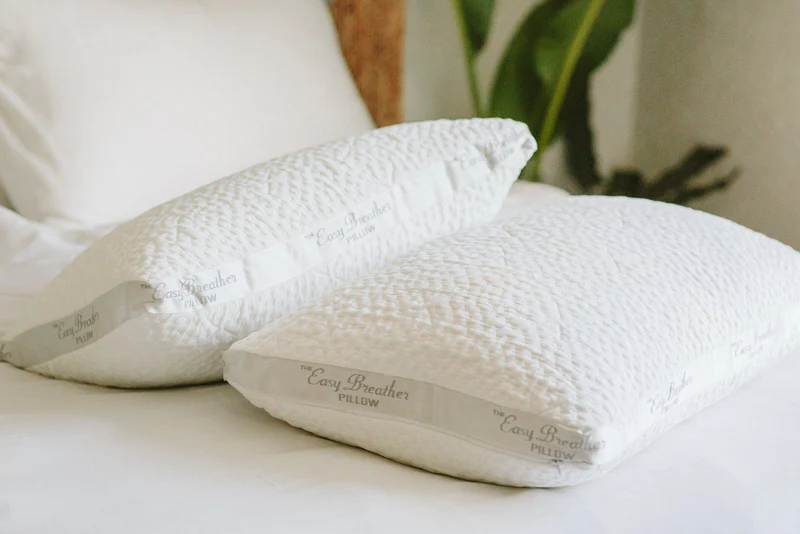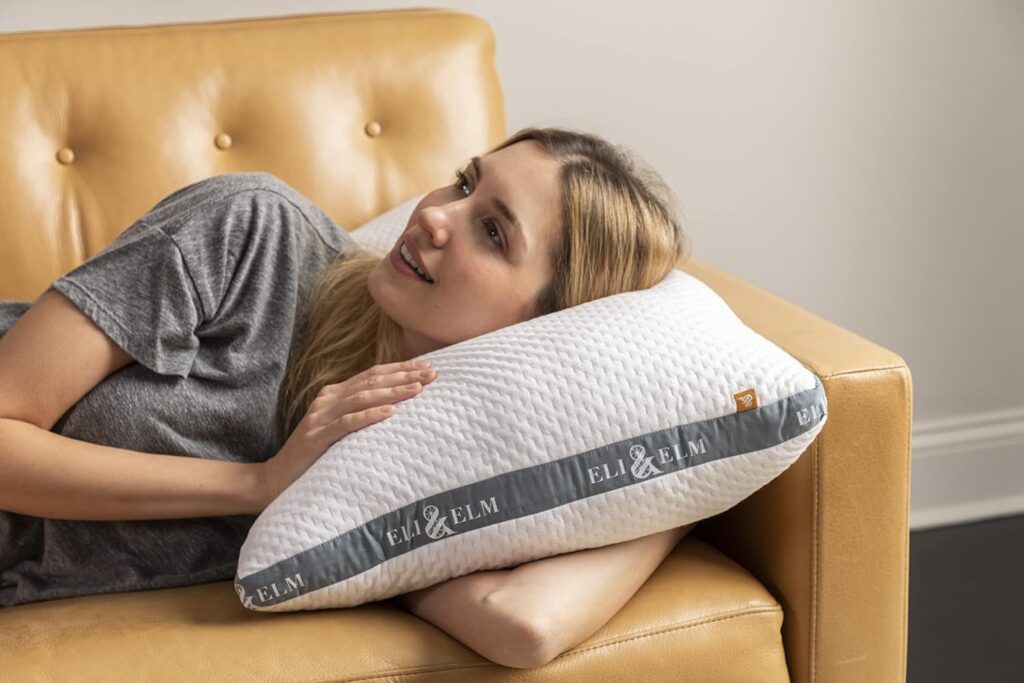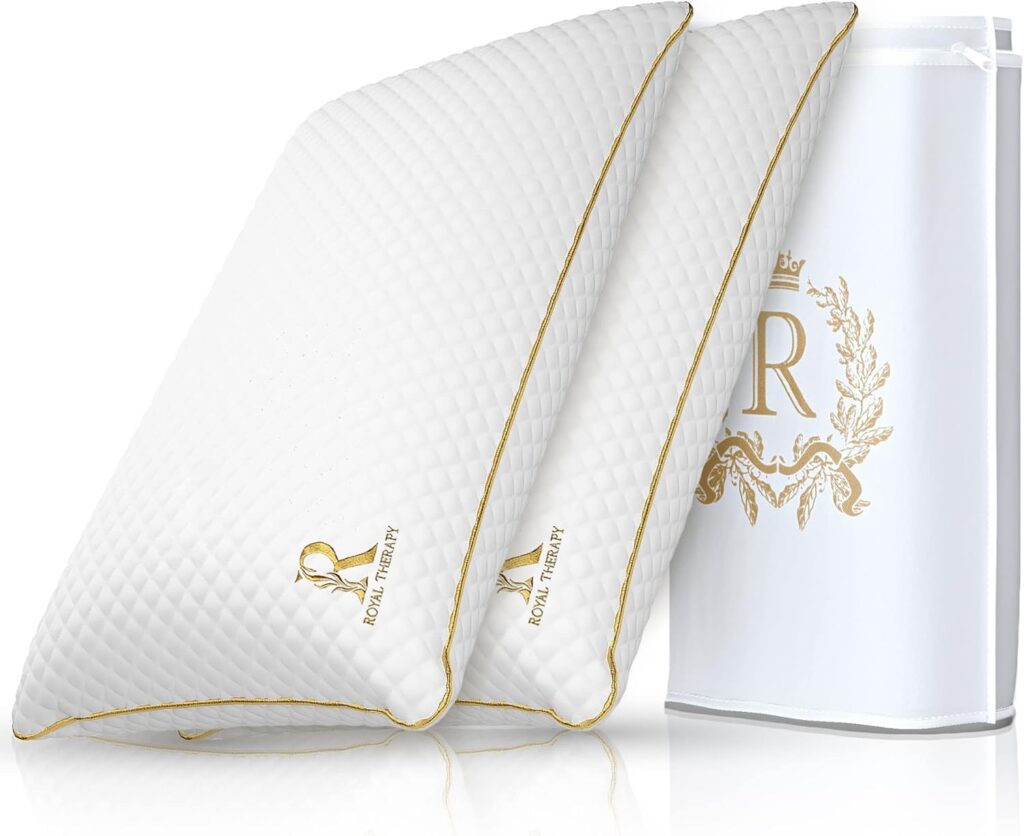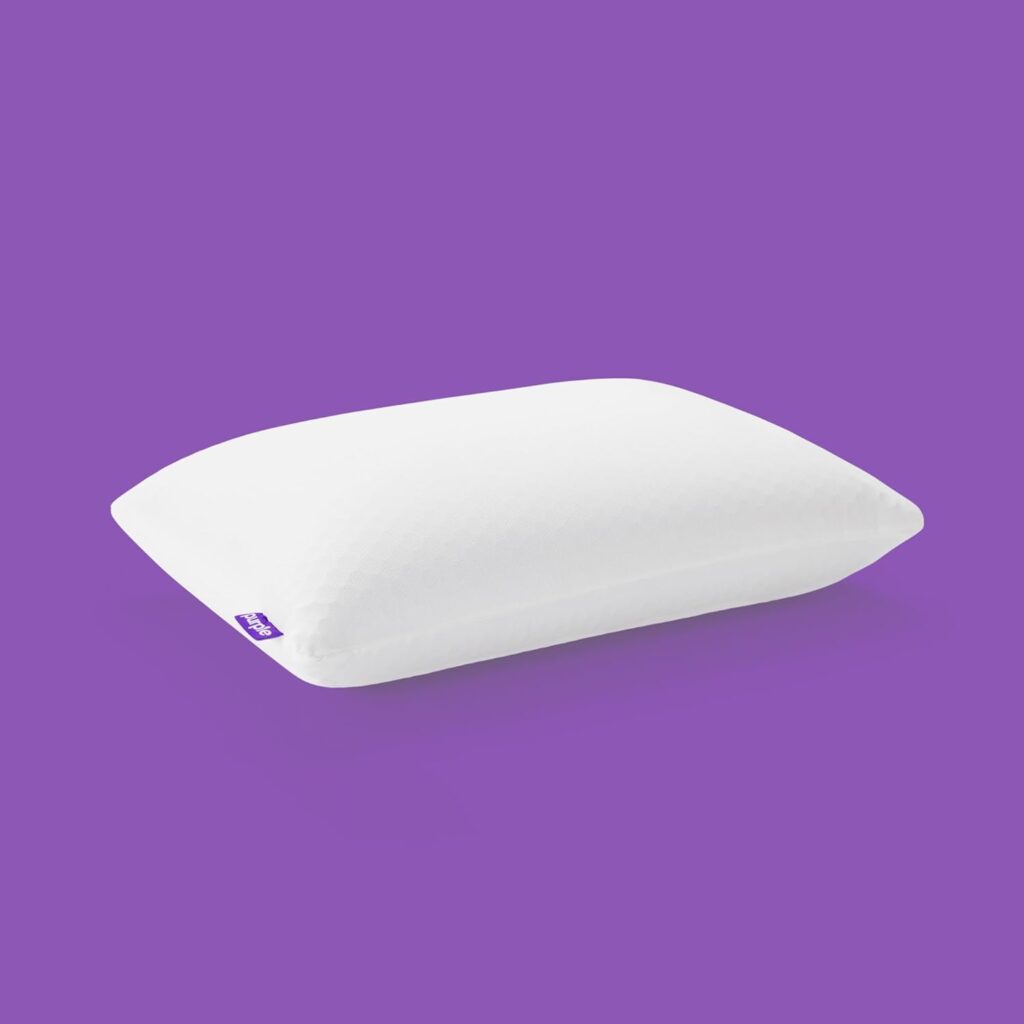5 Best Pillows for Neck and Shoulder Pain: Top Picks for Pain-Free Sleep
Waking up with a stiff neck or throbbing shoulders is no way to start your day. Trust me, I’ve been there—tossing and turning, trying to find a comfortable position, only to wake up feeling worse. Oftentimes the culprit is quite simply your pillow. The right pillow can transform your sleep, aligning your spine and easing neck and shoulder pain so you wake up refreshed.
In this guide, I’ll share the best pillows for neck and shoulder pain that provide proper support, comfort, and durability. From memory foam to ergonomic designs and cooling features, these pillows are designed to relieve tension and promote better sleep posture. Let’s dive in and find the best pillow for your needs!

This article contains affiliate links from trusted partners. As an affiliate, I may earn a commission on qualifying purchases—at no extra cost to you.
Why Your Pillow Matters for Neck and Shoulder Pain
Poor sleep posture can wreak havoc on your neck and shoulders. When your pillow fails to support your head and neck properly, it misaligns your spine, straining muscles and nerves overnight. A great pillow keeps your spine in its natural curve, letting those tense muscles relax.
Key Factors in Pillow Support
- Spinal Alignment: Keeps your head, neck, and spine in harmony.
- Cervical Support: Cradles the neck’s natural curve.
- Pressure Relief: Distributes weight to ease shoulder tension.
Your sleep position, body type, and pain triggers all play a role in finding the perfect pillow. Let’s dive into the top options.
Top Pillow Recommendations for Neck and Shoulder Pain
Below I’ve handpicked pillows that excel at relieving neck and shoulder pain, focusing on high-quality options from trusted brands:
- Best for Customizable Neck Support: Nest Bedding Easy Breather Adjustable Pillow
- Best for Side Sleeper Shoulder Relief: Eli & Elm Side Sleeper Pillow
- Best for Adjustable Pain Relief: Royal Therapy Hypoallergenic Pillow
- Best for Chronic Neck Stiffness: Tempur-Pedic TEMPUR-Neck Pillow
- Best for Combination Sleepers with Tension: Purple Harmony Pillow
1. Best for Customizable Neck Support – Nest Bedding Easy Breather Adjustable Pillow

- Material: Shredded gel foam (adjustable)
- Perfect For: Side and back sleepers needing tailored neck alignment
- Pain-Solving Features:
- Adjust the loft to fit your neck perfectly, preventing strain.
- Cooling gel foam reduces heat-related tension.
- CertiPUR-US® certified for safe, durable support
- Why It Helps: With over 20,000 reviews praising its versatility, this pillow lets you tweak the height to stop neck pain in its tracks—ideal if you wake up stiff or misaligned.
- Where to Get It: Award-winning Easy Breather Adjustable Pillow
2. Best for Side Sleeper Shoulder Relief – Eli & Elm Side Sleeper Pillow

- Material: Latex and polyester blend
- Perfect For: Side sleepers with shoulder pain
- Pain-Solving Features:
- Crescent shape cradles your shoulder, easing pressure points.
- Adjustable fill aligns your neck without tilting.
- Breathable cover keeps you cool to avoid stiffness.
- Why It Works: This pillow’s unique design takes the load off your shoulder while supporting your neck—perfect for side sleepers tired of waking up sore.
- Where To Get It: Eli & Elm Side Sleeper Pillow at Amazon
3. Best for Adjustable Pain Relief – Royal Therapy Hypoallergenic Adjustable Pillow

- Material: Shredded memory foam with bamboo-derived rayon cover
- Perfect For: All sleep positions with neck or shoulder discomfort
- Pain-Solving Features:
- Adjustable fill lets you fine-tune support for your neck and shoulders.
- Hypoallergenic, cooling bamboo cover fights heat-induced tension.
- CertiPUR-US certified foam molds to you without flattening out.
- Why It Helps: This popular hypoallergenic pillow allows you to adjust firmness, relieving pressure points and aligning your spine—great for couples or anyone wanting a reliable pain fix. With over 6000 positive reviews, customers rave about waking up without anymore neck aches.
- Where to Get It: Royal Therapy Hypoallergenic Adjustable Pillow
4. Best for Chronic Neck Stiffness – Tempur-Pedic TEMPUR-Neck Pillow
- Material: Firm TEMPUR memory foam (CertiPUR-US certified)
- Perfect For: Back and side sleepers with ongoing neck pain
- Pain-Solving Features:
- Contoured ergonomic shape locks in spinal alignment.
- Three size options for a custom fit to your body.
- Firm support prevents collapse, reducing stiffness.
- Why It Works: Its precise contouring targets chronic neck pain by keeping your spine neutral—no more waking up with that locked-up feeling.
- Where To Get It: Tempur-Pedic TEMPUR-Neck Pillow at Amazon
5. Best for Combination Sleepers with Tension – Purple Harmony Pillow
- Material: Hyper-elastic polymer (Purple Grid) with Talalay latex core
- Best For: Combo sleepers with neck and shoulder tightness
- Pain-Solving Features:
- Purple Grid adapts instantly, cradling your neck through position changes.
- Latex core relieves pressure without sinking too deep.
- Cooling mesh cover prevents heat from stiffening muscles.
- Why It Helps: Its ability to keep your neck aligned and shoulders relaxed no matter how you move during the night is a lifesaver for restless sleepers who are tired of waking up with aches and pains.
- Where to Get It: Purple Harmony Pillow at Amazon
Addressing Specific Pain Points
Different types of neck and shoulder pain require tailored solutions. Here’s how to match your pillow to your specific pain condition:
Tension Headaches: Finding Pressure Relief
If you struggle with tension headaches, your pillow choice matters significantly. Look for these key features:
- Contouring memory foam or latex that cradles your head while supporting your neck
- Medium-firm support to maintain proper spinal alignment through the night
- Even pressure distribution to prevent pressure points that trigger headaches
The right pillow reduces muscle tension in your neck, potentially decreasing both the frequency and intensity of your tension headaches.
Shoulder Impingement: Creating Space for Healing
Shoulder impingement syndrome demands special consideration in your pillow choice. The ideal pillow will:
- Feature a gentle slope to create necessary space for your shoulder
- Include cut-out sections in specialized designs to accommodate shoulder positioning
- Offer adjustable filling so you can customize the exact support level you need
These features reduce pressure on your affected shoulder, allowing for better circulation and healing while you sleep.
Cervical Radiculopathy: Supporting Your Spine’s Natural Curve
For those suffering from cervical radiculopathy (pinched nerves in the neck), maintaining proper cervical curvature is essential. Your ideal pillow will:
- Include a built-in cervical roll or contoured shape to support your neck’s natural curve
- Provide firm, consistent support to maintain proper neck alignment throughout the night
- Allow height adjustments to work with different sleep positions
The right support minimizes nerve compression, potentially reducing pain, tingling, and numbness. Always speak to a healthcare professional with any concerns.
Beyond the Pillow: Your Complete Sleep Solution
While finding the perfect pillow is crucial, it’s just one piece of your pain relief puzzle. A holistic approach delivers the best results.
Your Mattress: The Foundation of Pain-Free Sleep
Even the best pillow can’t compensate for a poor mattress. Your sleep surface should:
- Support proper spinal alignment from head to toe
- Relieve pressure points without creating new ones
- Maintain its supportive qualities for 7-10 years with proper care
Consider your sleep position and body type when selecting a mattress. Side sleepers typically need medium to medium-firm support, while back sleepers often benefit from medium-firm to firm surfaces.
Daytime Posture: Setting the Stage for Night Relief
Your daytime habits directly impact your nighttime comfort. Improve your posture with these simple techniques:
- Keep shoulders back and down, avoiding the forward hunch that strains your neck
- Tuck your chin slightly to lengthen your neck and reduce pressure
- Engage your core muscles to support your spine naturally
- Take movement breaks every 30 minutes when sitting for long periods
These small adjustments reduce muscle tension before it can develop into nighttime pain.
Bedtime Stretching Routine: Release Tension Before Sleep
Incorporate these gentle stretches into your bedtime routine to release the day’s accumulated tension:
- Neck Rolls: Circle your head slowly 5 times in each direction to loosen tight muscles
- Shoulder Shrugs: Lift shoulders toward ears, hold for 5 seconds, then release (repeat 10 times)
- Chin Tucks: Draw your chin toward your chest for 5 seconds, then release (repeat 10 times)
These simple movements take just minutes but can significantly improve your sleep quality.
Maintaining Your Pain Relief Investment
Your perfect pillow deserves proper care to continue providing optimal support.
Keep It Fluffy: Regular Maintenance
- Fluff daily for down and fiberfill pillows to maintain loft
- Gently knead memory foam or latex pillows to restore their shape
- Rotate regularly to ensure even wear across all sides
Clean With Care: Hygiene Matters
Follow these guidelines based on your pillow type:
Down and Fiberfill Pillows:
- Machine wash in warm water on gentle cycle
- Use mild detergent and an extra rinse cycle
- Dry thoroughly on low heat with dryer balls
Memory Foam and Latex Pillows:
- Spot clean with mild detergent solution
- Never saturate with water
- Air dry completely before use
Buckwheat Pillows:
- Remove hulls and wash cover separately
- Sun-dry hulls to refresh and eliminate odors
Know When to Replace: Signs It’s Time
Even the best pillows have a limited lifespan. Look for these warning signs:
- Persistent lumps or flat spots that don’t respond to fluffing
- Morning pain that wasn’t present before
- Visible stains or discoloration that won’t come clean
- Increased allergy symptoms or stuffiness upon waking
Most quality pillows should be replaced every 18-24 months for optimal support.
Strategic Sleeping Positions for Pain Relief
Your sleep position significantly impacts your neck and shoulder comfort. Here’s how to optimize each position:
Side Sleeping: The Preferred Position
Side sleeping generally offers the best position for those with neck and shoulder pain. Maximize its benefits by:
- Using a pillow that fills the ear-to-shoulder gap completely
- Placing a pillow between your knees to align your hips and reduce spinal twist
- Hugging a body pillow to prevent your top shoulder from rolling forward
The right pillow height is crucial—too high or too low will create strain rather than relieve it.
Back Sleeping: Supporting Your Spine
If you prefer sleeping on your back, proper support is essential:
- Choose a pillow that maintains your neck’s natural curve
- Place a small pillow under your knees to reduce lower back strain
- Avoid excess pillow height that pushes your head forward
Some pillows feature a lower central section specifically designed for back sleepers.
Stomach Sleeping: Minimizing Strain
While not generally recommended for those with neck pain, if you’re committed to stomach sleeping:
- Use an ultra-thin pillow or none at all to minimize neck twist
- Place a thin pillow under your hips to reduce lower back arch
- Consider a body pillow to help transition to side sleeping
Conclusion: Your Path to Pain-Free Sleep
Look, I’ve tried dozens of pillows over the years, and nothing has made as big a difference as finding the right match for my sleep style and pain points. After all my testing, I keep coming back to the Nest Easy Breather Adjustable Pillow. Its customizable fill lets you dial in exactly the right height and firmness, while the cooling properties keep you comfortable all night.
What makes this pillow stand out is how versatile it is—whether you’re a side sleeper with shoulder issues or a back sleeper with nagging neck pain, you can adjust it to fit your needs perfectly. I’ve recommended it to friends and family with various pain issues, and the feedback has been overwhelmingly positive.
Remember though, no pillow works in isolation. Pair it with good sleep habits, regular stretching, and proper posture during the day. Small changes add up to big results when it comes to neck and shoulder pain.
Don’t just accept waking up in pain as part of getting older. The right pillow can make a huge difference to your sleep quality. Pick a pillow that would work well for you and you might be surprised how much better your mornings can feel.
Sleep well, wake better—your neck and shoulders will thank you.
People Also Asked
What type of pillow is best for neck pain?
Cervical pillows or contoured memory foam pillows are often recommended for neck pain. These pillows support the natural curve of your neck, promoting proper alignment.
Can a pillow cause shoulder pain?
Yes, using the wrong pillow can cause or exacerbate shoulder pain. A pillow that’s too high or too low can put strain on your shoulders, especially if you’re a side sleeper.
How often should I replace my pillow?
Generally, you should replace your pillow every 18-24 months. However, this can vary depending on the pillow material and how well you maintain it.
Are memory foam pillows good for neck pain?
Memory foam pillows can be excellent for neck pain as they conform to the shape of your head and neck, providing customized support. However, the quality and density of the foam matter.
What’s the difference between a cervical pillow and a regular pillow?
Cervical pillows are specifically designed to support the natural curve of your neck, often featuring a contoured shape. Regular pillows are typically flat and don’t offer this specialized support.
Can buckwheat pillows help with neck pain?
Yes, buckwheat pillows can be beneficial for neck pain. They’re adjustable, allowing you to customize the support level, and they conform well to the shape of your head and neck.
Is a firm or soft pillow better for neck pain?
The ideal firmness depends on your sleep position and personal preference. Generally, a medium-firm pillow that maintains proper neck alignment is recommended for neck pain.
How do I know if my pillow is causing neck pain?
If you consistently wake up with neck pain or stiffness that improves as the day goes on, your pillow might be the culprit. Also, if you find yourself constantly adjusting your pillow at night, it might not be providing adequate support.
Can a water pillow help with neck pain?
Water pillows can be effective for neck pain as they provide consistent support and allow you to adjust the firmness level. Some studies have shown they can be more effective than standard pillows in reducing morning pain intensity.
What’s the best sleeping position for neck and shoulder pain?
Side or back sleeping are generally considered the best positions for neck and shoulder pain. Stomach sleeping is typically not recommended as it can strain the neck.
Key Takeaways
- Choose a pillow that maintains proper spinal alignment for your sleep position
- Consider innovative materials like water-filled or buckwheat pillows for customizable support
- Address specific pain points with targeted pillow features
- Maintain your pillow properly and replace it regularly
- Complement your pillow choice with good sleep hygiene and gentle exercises
- Pay attention to your daytime posture and workstation ergonomics
- Incorporate anti-inflammatory foods and stress-reduction techniques into your lifestyle
Health Disclaimer
The information provided in this article is for educational purposes only and is not intended to be a substitute for professional medical advice, diagnosis, or treatment. Always seek the advice of your physician or other qualified healthcare provider with any questions you may have regarding a medical condition or treatment before undertaking a new healthcare regiment.
If you experience persistent pain, numbness, tingling, weakness, or other concerning symptoms, please consult a healthcare professional promptly. Chronic pain can be a sign of underlying conditions that require proper medical evaluation and treatment beyond pillow selection.
Remember that proper treatment for neck and shoulder pain often involves a comprehensive approach, which may include physical therapy, exercise, medication, or other interventions as recommended by your healthcare provider.


